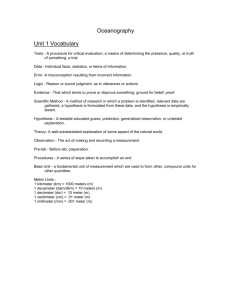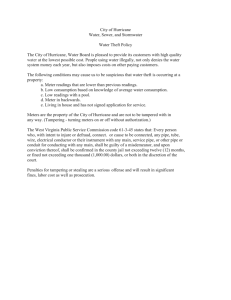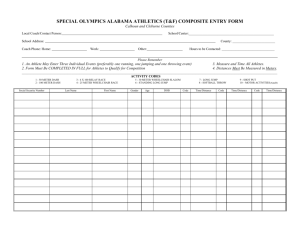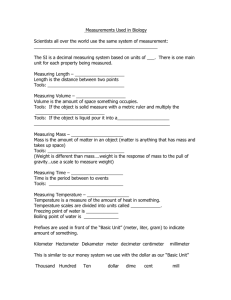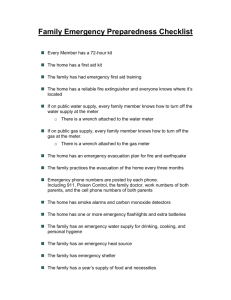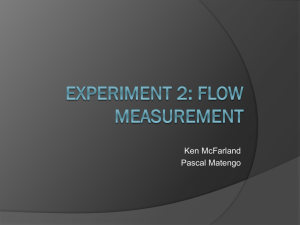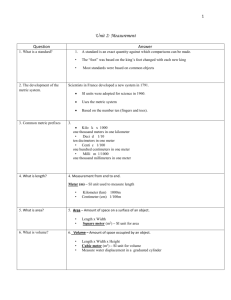Welcome to saving energy
advertisement
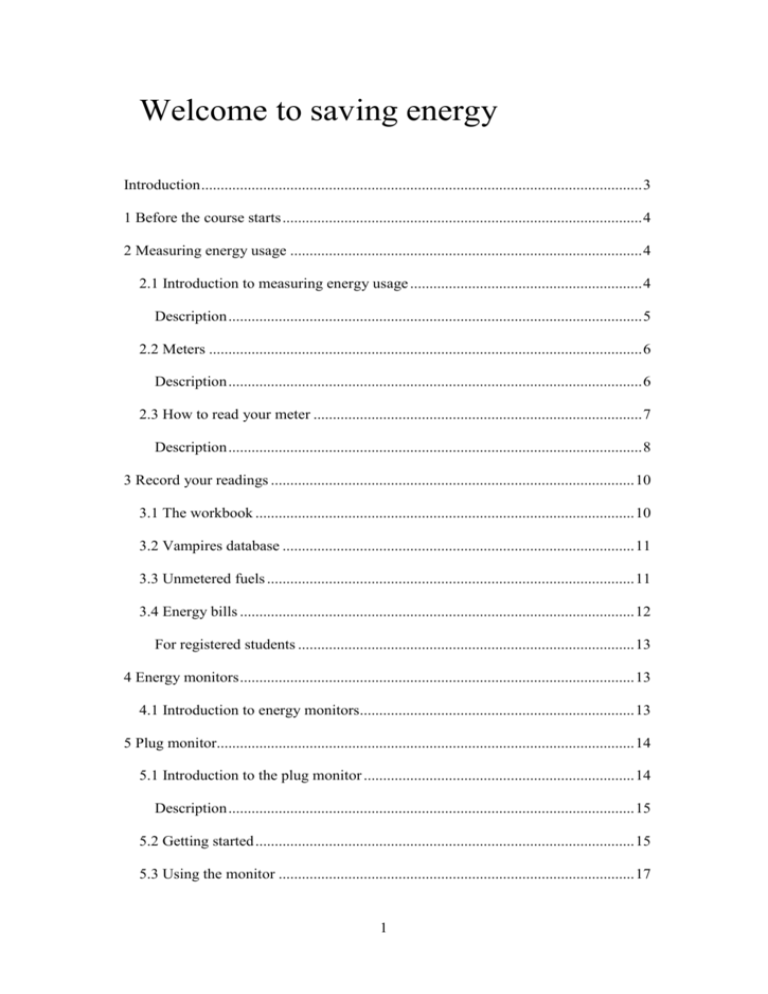
Welcome to saving energy
Introduction .................................................................................................................. 3
1 Before the course starts ............................................................................................. 4
2 Measuring energy usage ........................................................................................... 4
2.1 Introduction to measuring energy usage ............................................................ 4
Description ........................................................................................................... 5
2.2 Meters ................................................................................................................ 6
Description ........................................................................................................... 6
2.3 How to read your meter ..................................................................................... 7
Description ........................................................................................................... 8
3 Record your readings .............................................................................................. 10
3.1 The workbook .................................................................................................. 10
3.2 Vampires database ........................................................................................... 11
3.3 Unmetered fuels ............................................................................................... 11
3.4 Energy bills ...................................................................................................... 12
For registered students ....................................................................................... 13
4 Energy monitors ...................................................................................................... 13
4.1 Introduction to energy monitors....................................................................... 13
5 Plug monitor............................................................................................................ 14
5.1 Introduction to the plug monitor ...................................................................... 14
Description ......................................................................................................... 15
5.2 Getting started .................................................................................................. 15
5.3 Using the monitor ............................................................................................ 17
1
5.4 Difficult appliances .......................................................................................... 18
6 Home monitor ......................................................................................................... 18
6.1 Introduction to the home monitor .................................................................... 18
6.2 Getting started .................................................................................................. 19
6.3 Using the monitor ............................................................................................ 20
6.4 T152 monitor support ...................................................................................... 22
For registered students ....................................................................................... 22
What next? ......................................................................................................... 22
References .................................................................................................................. 23
Next steps ................................................................................................................... 23
Acknowledgements Acknowledgements ................................................................... 23
Acknowledgements Text ........................................................................................... 24
Unit image .............................................................................................................. 24
Acknowledgements Don't miss out............................................................................ 24
2
Introduction
Welcome to Energy measurements at home (T152), the OU's course for energy
savers. You are reading T152's Welcome unit.
This open-access component is available both to registered students (on the course
website) and to visitors. It is provided so that:
1. Visitors may gain an insight into the workings and material of the course.
2. Visitors may experience for themselves how a few simple measurements can
identify energy savings in their homes.
3. Registered students can prepare on OpenLearn before the course website opens,
in particular by starting their systematic monitoring of home energy usage.
If you are a visitor please ignore passages addressed to registered students.
What you can expect
T152 is about the principles, practice and understanding of energy usage in a
domestic setting. We, the course team, created it because we believe that measuring
your energy usage can give you more understanding and control of that usage, and
hence of your living expenses, your impact on the planet and perhaps even the
market value of your home.
You should expect to spend between eight and ten hours a week studying it.
However, this will vary from person to person and with different parts of the unit,
because there's quite a lot of practical activity and people do practical things at
different speeds!
Why T152 works
Students who engage with the course often reduce their home's energy usage, and
sometimes magnificently: a student in the pilot presentation reported a 60% yearon-year reduction in electricity bills. We believe that of the features of the unit that
are involved in this process, the following are paramount:
• you gain knowledge about energy and how it behaves;
• you develop a deep understanding of your home's energy usage, derived from a
programme of measurements;
• you conduct a systematic review of every relevant aspect of your home;
• a structured programme of study focuses your attention for the duration.
When we look in detail at the actions that gave students their savings, we often find
that these are not the 'usual suspects', i.e. not actions you typically see in the
3
media's 'Top 10 energy-saving tips'. This is a consequence of the knowledge,
understanding and systematic review working together.
This unit is from our archive and it is an adapted extract from Energy
measurements at home (T152) which is no longer in presentation. If you wish to
study formally at The Open University, you may wish to explore the courses we
offer in this Environmental sciencecurriculum area.
Learning outcomes
By the end of this unit you should be able to:
get an initial feeling for how energy measurements lead to energy savings;
see how a simple measurement experiment is conducted;
start to read your meters;
embark on a search for the energy history of your home in past fuel bills;
install and use the two types of energy monitor associated with the course;
conduct measurement exercises in your home;
possibly reduce your home's energy consumption.
1 Before the course starts
If you are a registered student of T152 then you are recommended to start
collecting energy measurements before the course begins.
By the opening date of the spring–summer presentation, you may have turned off
your space heating and will have to wait for next autumn before you can examine it
in detail.
By the opening date of the autumn–winter presentation, your water heating may be
concealed within your space heating, and you would have to spend periods with
each of them turned off in order to isolate and measure the other.
An early start to data collection may avoid these annoyances.
If it was too late for you to follow this recommendation before the course began
then you should start collecting measurements as soon as possible. This simply
means that you need to act upon the sections on reading your meters, unmetered
fuels and the home monitor as your top priority. Raise any difficulties that you may
be having in the forum.
2 Measuring energy usage
2.1 Introduction to measuring energy usage
The following material is available to both registered students on the course
website and visitors on OpenLearn.
4
Why measure?
You can't control what you can't measure. Control requires understanding, and
measurements create understanding.
Your motives for taking control of your home's energy usage will be personal.
Improvements in costs, property values, carbon emissions and resource depletion
are typical, and T152 expands on each of these. But the most appealing reason I've
come across is based on a past student's observation of her family. Children are
scared by media clips about climate change: 'Is there a happy ending?'. It means a
lot to them if their parents are clearly in control, as shown by actions and expert
explanations of what the family is doing and what it still has to do. They know the
difference between these and empty reassurance.
What to measure?
Many home energy measurements have one simple objective: to quantify the
amount of energy used between points in time, and to translate this into an average
over a set timescale. Here is an example in which the points in time are two widely
separated meter readings and the average is per day.
Description
This shows a calculation of daily average usage from two meter readings. The first
reading is 6734 units, taken on 31/10/2002; the second is 23 667 units, taken on
27/10/2008. This gives a total usage of 16 933 units over 2188 days. Dividing one
figure by the other shows that the average number of units used per day was 7.739.
End of description
The other typical objective is to uncover patterns (such as a sudden change) in a
series of measurements. This requires a sequence (rather than a pair as shown
above), taken at more or less regular intervals.
You can obtain the measurements you need in several ways:
read meters;
measure unmetered fuel;
analyse energy bills;
monitor an individual appliance;
monitor the whole home.
5
The example above was based on two energy bills. Meter readings, fuel
measurements and monitor readings are used over much shorter time intervals.
You can read meters, measure fuels and analyse bills without using monitoring
equipment. Therefore you can – and should – begin such measurements before
receiving monitors in the course mailing.
2.2 Meters
Meters measure energy usage at the level of the whole house. They are standard in
domestic electricity and mains gas supplies, being essential to the pricing
mechanism. They are sometimes found in off-mains supplies of liquid petroleum
gas, especially where one bulk storage unit supplies multiple homes.
An energy meter counts continuously from the moment it is activated. It has no
concept of the discrete deliveries of liquid and solid fuels. Instead, fuel usage is
measured between two arbitrary points in time – meter readings – and is the
difference between the units counted at the second reading and those at the first.
Figure 1 shows an image of an electricity meter reading.
Figure 1 Electricity meter reading
Description
This is a photograph of an electricity meter. At the top are six revolving digits, five
black and one red, with the magnitude of each digit given underneath. The first five
6
digits are currently 2, 4, 5, 6 and 0, with the sixth (red) digit sitting about halfway
between 7 and 8. Their magnitudes are 10 000, 1000, 100, 10, 1 and 1/10
respectively, but the red digit also has a graduated scale to the right whose
magnitude is 1/100. This means that the reading on this meter is 24 560, with the
sixth digit giving precision to fractions of a unit. Below the digits are the letters
kWh, showing that the meter is measuring usage in kilowatt-hours. At the bottom
of the meter is a rotating disc that gives even greater precision than the six digits at
the top.
End of description
The unit here is a measure of energy, the kilowatt-hour (kWh). Electricity meters
are unique in measuring energy content directly. Gas or liquid meters measure a
unit of volume, which must be translated into energy content.
T152 teaches what you need to know about measures of energy and their
translation.
2.3 How to read your meter
T152's Monitor installation guide provides extensive guidance on locating and
accessing energy meters.
The safety advice in the Monitor installation guide applies whether or not you have
registered for the course, and whether you are installing a monitor or just want to
read a meter. You must study the safety advice in full. Be careful, particularly if
your meter is hard to reach without the risk of a trip, slip or fall. Care may include
having someone with you.
If you have any kind of digital camera, you can with a little practice get an
excellent image of virtually any meter. It stops motion (gas meters can whizz
round), gives you all the time you need to interpret a reading, and increases your
ability to take a reading at a regular time of day even if you are too busy to record it
immediately.
Interpretation
The images in the Monitor installation guide reveal an immense variety of energy
meters. They do, however, share certain features, so that general guidance for
reading them is feasible. All the energy companies appear to provide such guidance
on their websites, so look at your suppliers' sites. In case yours are unhelpful, here
are links to two 'How to read your meter' pages.
British Gas
Southern Electric
Precision
7
Disregard just one part of the energy companies' guidance when you measure your
own energy usage: the bit about ignoring the least significant digits, i.e. the
precision of the reading. Energy suppliers bill you only for whole units used, so
they don't need or want the part units. You do.
Look carefully at the earlier image of an electricity meter. The supplier would bill
only for the whole units, in this case 24 560 kWh. The red digit to the right of that
is precise to 0.1 kWh, i.e. 24 560.7 kWh. The graduated scale to the right of the red
digit is precise to 0.01 kWh, i.e. 24 560.74 kWh. Two decimal places are normally
sufficient for home electricity meter measurements. The moving disc gives even
more precision, revealing the reading to be 24 560.7379 kWh – this level of
precision is more of a nuisance than a help.
The next image (Figure 2) is of a gas meter. You can see that its unit is a cubic
metre (m³) of gas. Some older gas meters measure cubic feet (ft³)) and you are
billed in a unit of 100 ft³).
Figure 2 Gas meter reading
Description
This is a photograph of a gas meter. At the top is information about the meter's
manufacturer and some technical details that aren't relevant to T152. Below these
are eight revolving digits, with the notation m3 to the right showing that the meter
is measuring usage in cubic metres. The last three digits are surrounded by a red
box and separated from the first five digits by a comma; the final digit has a
graduated scale on the right to provide even greater precision. The digits are
currently 1, 0, 5, 4, 5, 5, 9 and 0.
End of description
In this case, the decimal places in the red box give enough precision for most
purposes, i.e. 10 545.590. Three decimal places are normally sufficient for home
gas meter measurements. However, it is sometimes possible to use a gas meter to
investigate a single device, such as a cooker, and while doing that you might also
8
be interested in greater precision, such as the graduated scale on the last digit in this
image. Reading between the graduations, it gives 0.0001 m³) precision, and this
reading is 10 545.5901 units.
Activity 1 Reading your meters
With due regard to your safety, as advised above, try to read each of the energy
meters in your home. Write down the readings to (a) the maximum possible
precision and (b) the precision recommended above. Also note the date and time of
the reading as precisely as you can.
Remember the trick of taking meter readings with a digital camera.
Heed and act upon whatever lessons this activity teaches, such as:
ease of access to the meters and their visibility;
difficulties in interpreting the readings;
difficulties in being precise enough;
using a clock or watch at the same time as reading the meter.
Practise again in an hour's time, and again tomorrow. You want meter reading to
become second nature to you. You will also start to gain an idea of how much
energy or fuel is used by your home over these timescales.
When to read your meter
You need to read your meters (and measure other fuels) regularly before and during
your study of the course. It is useful to have at least a fortnight of daily readings for
later analysis of patterns. As enthusiasm wanes, you might miss out some days.
When more specific measurements are needed, the course text says so.
At one point in T152 you will study how to analyse and exploit variations in
measurements. A particularly useful example is the variation in heating demand in
response to changes in outdoor temperatures. With this in mind, you should try to
take at least seven consecutive daily readings of whatever fuel you use for space
heating. Any seven days will do – whichever are most convenient for you –
although a weather forecast that suggests a significant change in average
temperature during the week ahead might be a good prompt.
This point is especially important if you have registered for the spring–summer
presentation. Take the measurements described above before your heating season
finishes. If it has already finished, you may be able to discuss other students' results
in the course forum, then get your own when heating restarts next autumn.
Try to plan all meter readings so that you stick as closely as possible to the same
time each day. If you can't keep to the same time it isn't a disaster, but it does mean
that your calculations will have more uncertainties built into them. Include both the
date and the time alongside the quantity when you record any reading. The next
page describes how records are kept in T152.
9
3 Record your readings
T152 provides a workbook in which you record your data and which provides
calculations and guidance for you. Essential reading to check that you can use the
workbook is on the T152 web page entitled Before you register, to which the
registration process directs you. If you have not looked at it, go there now.
3.1 The workbook
You can download the course workbook by clicking here: Workbook.
If you are reading this on OpenLearn, the link above will provide you with a much
reduced version of the course workbook to enable you to record data. If you are a
registered student waiting for the course to open, I strongly urge you to use this
version in the meantime. It is designed so that data can be copied across when the
full workbook becomes available.
When you need to use the workbook, the course text will direct you to the required
worksheets.
The following activity gives you an opportunity to use the workbook and to save
energy.
Activity 2 A Vampire experiment WORKSHEET: METERS, WEEK 1
'A Vampire experiment'?! The name comes from David MacKay's book
Sustainable Energy – without the hot air. Vampires are gadgets that consume
power while you aren't looking, sucking the energy lifeblood from your home.
First read chapter 22 from MacKay's book, which is about efficient energy use.
Your goal is to reproduce his experiment in your home, substituting your meter
readings. Here is a suggested approach:
Read your electricity meter immediately before and after periods in which
the home is properly at rest. 'At rest' means that nobody is in or everybody is
asleep, and no appliances are on except the 24-hour background that you
leave on, e.g. fridge-freezer, security alarm, fish tank, etc. Put a reminder to
read the meter in a place where you are unlikely to miss it when you get up
or return home.
Some periods must reflect your normal household habits. Before other
periods, you should systematically switch off and unplug every unnecessary
gadget for the duration. 'Unnecessary' gadgets are any that are left on standby
or inactive, such as kitchen and audiovisual equipment, chargers that have
done their job, and most computers and stuff connected to them. 'Necessary'
gadgets are those whose very purpose involves being left on and active,
without which someone or something might be harmed or damaged, such as
the fridge-freezer, security alarm and fish tank. Leave these on.
10
It might be best to begin with all the normal periods, because embarrassment
and the desire to save money can make you unwilling to switch some
vampires back on to complete the activity!
As you can see from the variability in MacKay's Figure 22.2, just one period
of each type can give a reasonable impression, but several combined give a
more representative view. This is very typical of home energy measurements.
Enter each meter reading (both the start and the end of the period) with its
exact date and time into the 'Meters' worksheet. Very precise readings are
worthwhile in this instance, as periods may be short and energy levels low.
To discover what the results tell you, copy the relevant readings to the
'Vampire experiment' calculator in the 'Week 1' worksheet.
The Vampire experiment does two things for you:
It gives you an estimate of savings that may be available if you keep the
vampires switched off.
It effectively begins your systematic investigation of your home, with your
first meter readings.
What it doesn't do is make the savings for you. Only you can do that, by keeping
the vampires switched off. In some cases this will entail a change in household
behaviour and personal habits.
T152 probes deeply into household behaviour and how it might be changed.
3.2 Vampires database
Students registered on T152 have the opportunity to contribute to an international
database of vampire experiments and other data. If you are not registered but would
like to contribute, the easiest way is to email your completed workbook to the
address given on the T152 introductory page – but wait until you've quantified each
vampire.
3.3 Unmetered fuels
Unmetered fuels pose problems. Measurement of their energy content pushes the
bounds of possibility. Nonetheless it is worth trying, because non-electric fuels are
hugely important, especially for space heating, and they dominate the domestic
energy usage of many countries.
One problem, which unmetered fuels share with mains gas, is that their energy is in
a form that can only be measured indirectly – chemical energy. (T152 explores
various forms of energy). As you saw with the example gas meter, such fuels are
generally measured in units of volume (gas in cubic metres, liquids in litres) or
weight (solids in tonnes or kilograms). Electricity meters are unique in directly
measuring the amount of energy used.
In the case of mains gas, the supplier generally shows the units of volume on the
bill, together with a calculation of the energy equivalent (in kilowatt-hours) based
11
on standard values for the amount of energy per unit. You then pay for the energy.
The standard values are normally determined and published by your government or
a regulatory body.
Suppliers of unmetered fuels, who are less regulated, are usually less helpful. You
pay for the volume or weight delivered, often with no indication of energy content.
To calculate this, you need to know what standard values to apply. This is not a
problem with T152, since its workbook includes values from national statistics.
Even so, because energy content can vary, the calculation can only ever be an
estimate.
The other main problem is that many fuels – or the ways they are stored and
consumed – make it difficult to approach the degree of precision you get from a
meter. Imagine weighing coal to the nearest gram.
However, the fact that unmetered fuels are difficult to measure is no reason to give
up on them. I once lived in a house with oil-fired heating. A pipe up the side of the
oil tank gave a visual reading of the fuel level, but no actual gauge markings. It
would have been possible to measure the dimensions of the tank and work out how
much oil was represented by a distance in the pipe, even one millimetre. It would
also have been possible to use sticky tape and labels to mark and measure daily or
weekly levels (depending on how fast the oil was being used). Whatever the fuels
or their deliveries throw at us, detailed measurements may depend on such
ingenuity.
For these reasons, most measurements of unmetered fuel stay at the summary level
and use the long timescale between deliveries. The documentation with each
delivery tells you exactly how much you receive and when, and then all you need
are the standard values that determine energy content. This brings us neatly to the
next way of measuring energy usage, which is to exploit your past bills.
3.4 Energy bills
Energy bills contain useful information. You knew they would come in handy one
day, didn't you?
Ideally you need bills for all the fuels used in your home. My inquiries suggest that
the majority of households keep their bills, although whether these can actually be
found when needed is a different matter.
Activity 3 Collect your energy history
Find as many past energy bills on paper and online as possible. Sort them into time
sequence, note any gaps, and search even harder for the remainder. This is exactly
what I did when preparing T152.
Energy bills sometimes show meter readings that have been estimated by the
supplier rather than taken from the meter. For some purposes these are not useful,
but for others they are. The course workbook allows you to identify estimated
12
readings and to optionally exclude them from calculations. Therefore, include
estimated bills in your collection.
If you have gaps in the sequence, or no bills at all, you might obtain a useful recent
history by registering with your fuel suppliers' websites and searching therein. Both
of my suppliers have them. If this fails you might phone, explain that you are
studying an Open University course on energy and ask them to send your complete
records of energy usage from the time you opened an account with them. The more
people who do this, the more the suppliers will get the message that the energy
world has changed.
If you can find no history at all (e.g. you have just moved into your home) Week 8
will be more important for you. Among other topics, it teaches how to estimate a
full year from a part year’s readings by making adjustments for seasonal patterns.
For registered students
You are recommended to undertake this activity before the course begins, purely as
a precaution in case it takes more time than expected. If this recommendation
comes too late for you, try to find at least one bill for each fuel (the older the better)
so that you have something to use in Week 2. The course includes an extended
version of the 'Meters' worksheet in which you can also record bills and deliveries.
4 Energy monitors
4.1 Introduction to energy monitors
Present-day meters have their limits as energy measurement tools. When these
limits are reached we use energy monitors instead.
T152 looks at future smart meters that may alter these limits. The limits are reached
in two sets of circumstances, which are so common that they are effectively the
norm:
You need to measure individual appliances in isolation, without switching
everything else off.
You need measurements to continue while you are not present, for example
overnight, when you go away, and – most likely – when you get fed up with
trailing back and forth between the meter and the room you are in.
T152 provides two energy monitors. Each focuses primarily on one of the cases,
but also helps to address the other.
1. The 'plug monitor' is for individual devices. It sits between an electrical
socket and any device with a plug, to measure the amount of energy used. It
works unattended for as long as you want to monitor the device.
Unfortunately there is no equivalent for gas appliances.
2. The 'home monitor', like your electricity meter, measures the total amount of
electricity being used by your home, but in addition it keeps a history that
13
you can read later. It can also be used to measure most individual appliances
that are wired directly to the mains rather than through a socket.
Students of T152 are sent both monitors in the course mailing. Alternatively you
may already own one or both types of monitor. Some makes do not have the
desirable features for which T152's models were selected, but you can use them for
most purposes.
I will look at the plug monitor first. It is much simpler, and it provides a small piece
of information that you need in order to set up the home monitor correctly. It also
extends the Vampire experiment.
5 Plug monitor
5.1 Introduction to the plug monitor
A plug monitor is a good way to become accustomed to handling monitoring
equipment. It is trivial to set up, and really you only need to learn how to interpret
its display.
Figure 3 shows two typical plug monitors inserted into mains sockets, one with the
power lead of some device plugged into it.
14
Figure 3 Two common models of plug monitor, showing voltage readings
Description
This is a photograph of two plug monitors, both plugged in to wall sockets. The one
on the left gives a reading of 236.9 volts, while the one on the right gives a reading
of 237 volts.
End of description
In general, plug monitors appear to be accurate to within small tolerances when
used in power sockets whose operating characteristics fall within the range of a
normal domestic electricity supply. The range is usually printed on the reverse of
the unit or in its documentation.
5.2 Getting started
There is no installation procedure, and the device is very simple. Read the maker's
instructions and plug it in.
15
Most plug monitors enable you to enter the price of your electricity so that they can
display costs. T152 does not require this because the course workbook contains
more effective costing tools.
Ignore your natural impulse to immediately plug an appliance into the monitor.
That is a distraction and can cause initial confusion. Test the monitor alone first,
without a plug in it. Just insert it into a wall socket and switch on the socket. The
monitor may test its display, and then show either a zero reading or the timer
counting seconds. If so, it works. If not, try it in another socket that you know has
just powered an appliance. If it still shows no display, contact the maker; if your
monitor is from your T152 course mailing see T152 monitor support.
Next, become accustomed to what the buttons do. When no appliance is plugged in,
the display shows some boring zero values – ignore these. Instead, try to decipher
the various smaller letters next to each value, which are symbols for units of
measurement. (T152 explains measurement units in detail). The following units are
more significant than the rest:
The most commonly used reading is the power consumption, measured in
watts (W).
Another important reading is the total energy used since you last switched on
at the plug, measured in kilowatt-hours (kWh). (T152 explains the difference
between 'power' and 'energy').
The timer counts the time elapsed since you last switched on at the plug.
The voltage of electricity at that plug socket, measured in volts (V), is helpful
when setting up the home monitor, so make a note of it when you see it.
T152 plug monitor only
The course kit includes the Eco-eye Plug-in monitor, which is also available under
other brands. Here are the quickest ways to reach its important measurements.
Power (W): press the middle POWER button.
Energy (kWh): press the right-hand COST button. It is the upper of the two
values displayed there. It is precise to four significant digits, which suggests
that the designer actually knew what energy measurers need, unlike some
others.
Timer: press the right-hand COST button and then the left-hand FUNCTION
button (once). The FUNCTION button is also used to tour round this and
various other readings one by one. Another good bit of design – the timer
includes days if you leave it that long.
Voltage (V): press the FUNCTION button a few times, waiting for the V to
appear.
Find the voltage display. You need this to set up a home monitor. As I write, mine
reads '244 V', but you can see from the earlier image that it isn't always the same. It
fluctuates with the mains voltage being delivered to your home, which depends on
what's happening on your electricity grid. My best advice is to take readings over a
day – when you get up, in the afternoon and in the evening – then work out their
average. I concluded – possibly wrongly – that my home's norm is about 244 V,
16
and I have seen values from 236 V to 245 V, including a 4 V drop within one
minute.
5.3 Using the monitor
To accustom you to using the plug monitor here is an activity that continues the
Vampire experiment you met previously.
The activity asks you to visit each of the gadgets that you switched off (or are
planning to switch off) in the Vampire experiment. You will cross-check the
estimate of potential savings calculated from meter readings. Cross-checking is
another typical energy measurement activity.
Activity 4 Quantifying your vampires WORKSHEET: WEEK 1
Visit your vampires one by one. For each gadget, insert it into the plug monitor and
switch on at a socket. (T152 includes a video of the plug monitor in use).
Ensure the vampire is in the same operating mode that you would have left it in
during the normal periods of the experiment already described. Since it is a
vampire, this mode would usually be Standby or Inactive, but perhaps fully On is
your only option. Whatever the mode, it must be the same as when you took meter
readings or it isn't comparable, and that's a failure of experimental procedure.
Once the vampire is in the relevant operating mode, measure its power
consumption in watts. If the reading fluctuates, estimate its midpoint as best you
can (see below). Record the amount, along with the vampire's identity, in the 'Week
1' worksheet.
The worksheet adds up the power consumption of all the vampires, and enables you
to cross-check this total against the difference between your normal and
experimental rest periods.
Now your workbook is ready for submission to the Vampires database.
You are certain to find that some vampires are insignificant, despite their
reputations in the media. In contrast, some can be extraordinarily greedy, to the
extent that you wonder how anyone could design a product so badly. Audiovisual
equipment is particularly liable to this, although the 'course record' so far is held by
two microwave ovens, both guzzling 60 W on standby. Needless to say, the owners
now unplug them when not in use, saving over £60 per year.
If you want to, you can also measure the vampires' power consumption when they
are switched on fully and in active use. You may find at least one gadget whose
power reading fluctuates. Don't worry. The monitor is not wrong, and nor is your
appliance. The fluctuations are a normal result of interactions between your
electricity supply and the way that appliances and monitors work. They are not
confined to this particular make or type of monitor. Although they can be a
17
nuisance, they are part of the reality of energy measurement. (T152's video of the
plug monitor shows how to cope with fluctuating readings).
In theory, the cross-check should show that your two estimates match; in practice,
they may not. A difference can have several causes: perhaps some wired-in or
impossibly sited vampires that you couldn't measure (see the next page),
fluctuations in power consumption and voltage during the rest period, or – heaven
forbid! – a failure of experimental procedure.
5.4 Difficult appliances
Sometimes an appliance is sited so as to make the plug monitor unusable or
unreadable. Solutions known to work include:
'Move' the appliance (e.g. take the light bulb from a ceiling rose to a plug-in
lamp stand to measure it).
'Move' the socket by using an extension lead. Some leads consume extra
energy, so first measure the lead alone at another socket, and subtract
whatever reading it gives from subsequent readings of appliances plugged
into it.
With a torch and a mirror you can read a plug monitor in some very awkward
places. But beware: the digits 2 and 5 are mirror images and are therefore
prone to reading errors.
6 Home monitor
6.1 Introduction to the home monitor
Home monitor technology is – in effect if not in physical connection – an extension
to the electricity meter. It too measures the electrical energy entering your home. It
exists because of the meter's limitations as a measuring device, which I outlined
earlier:
It enables an individual appliance to be measured because it has an easily
portable display unit, which you can watch while you control the appliance.
It enables you to measure while you are not present because it monitors
continuously and records history.
Nonetheless, in both these aspects the technology could do better and is therefore
still developing.
Briefly, home monitors normally have two major components that communicate
wirelessly. One is the sensor and transmitter unit, which monitors the power cable
entering your home. The other is the display unit, which shows you what the
transmitter has measured. A home monitor is described in great detail in the
Monitor installation guide, and a video of its installation and use is shown below.
18
And finally, here's what happens when you switch on an electrical device. The
initial reading is 0.33 kW. When you switch on the kettle it goes to just over 3 kW,
which means that the kettle consumes power at a rate of about 2.7 kW or 2700
watts.
All models of home monitor based on this technology are less accurate than plug
monitors, perhaps by an order of magnitude. This is an inevitable consequence of
using a non-invasive magnetic sensor. Nevertheless, I personally have always
found them sufficiently accurate for T152's purposes. Just don't imagine you can
check your bills with them.
The next page describes one precaution you need to take, which is to set the
reference voltage correctly. (The T152 wiki includes a page devoted to various
other aspects of monitor accuracy).
6.2 Getting started
It takes more time to install a home monitor than a plug monitor but it is still a
relatively easy procedure that many thousands of ordinary homes have done.
The home monitor has no role in the present version of the Vampire experiment, so
from that viewpoint there is no urgent need for it. However, if you are registered
for T152, I do suggest you install it as soon as possible after receipt. If you haven't
done this kind of thing before, it may take some time and you should allow for that.
In the unlikely event of a problem, you'll have more time to find the cure before it
hampers your studies. You'll also have more data available for analysis in the
course, because the home monitor will start to collect history as soon as it is
installed.
It is not advisable to ask someone else to set up a monitor for you unless they will
be your helper throughout the course. If you did, you would lose control of the setup and you would not be able to explain what happened in the unlikely event of a
problem. Furthermore, some features of the set-up are experiences that may later
increase your understanding of course material, even if at the time they mean
nothing to you.
The first task is to unpack the box and read the maker's instructions, concentrating
on setting up the monitor for first use. This also enables you to check that all parts
are present and appear undamaged on external inspection. In addition, the Monitor
installation guide contains detailed guidance on installing the sensor and
transmitter, including safety advice.
During the procedure to set up the home monitor, you will be asked to enter some
reference data. In two cases, the maker's instructions are inadequate for T152's
needs. They are as follows.
Voltage. Enter the value that I asked you to measure with the plug monitor, or as
close to it as the set-up procedure allows. Unless you do this, the home monitor will
give less accurate readings.
19
Cost of electricity. Do not enter your electricity price. Instead, enter 1.000 (or your
model's equivalent). This fools the monitor into displaying all history in kilowatthours of energy rather than in money. Energy history is vital for measurement
purposes, while cost history is worthless; so unless you do this, you might as well
not have the monitor at all. T152's workbook calculates costs.
T152 home monitor only
The procedure to set the voltage runs immediately after you insert batteries into the
display unit, as per the maker's instructions. You can repeat it as often as you want,
although when you remove a battery you lose history for the current (unfinished)
hour, day, etc. and you must reset the time. So do it just after a change of hour, or
even midnight! All other history is adjusted to reflect the new voltage.
I also find it helps to set the currency to either of the two foreign symbols, not to
my own, so that I don't associate the energy values with costs.
It seems to be worth attaching the supplied antenna to the home monitor's display
unit, even if you plan to keep the display unit near the transmitter. Before I attached
mine, I would occasionally see a 'missed heartbeat' in the data ('--.--' kW);
afterwards, I saw none whatsoever. Attaching the antenna can be a fiddly job. It is
easy to lose the tiny screw that fixes it to the back of the display unit. To avoid this,
work at a table over a piece of paper or cloth.
6.3 Using the monitor
You can use a home monitor to measure larger devices individually and to measure
the history of your whole home's electricity usage.
Individual devices
In individual device is measured with the monitor's 'kW' display, which measures
the home's power consumption. It is the equivalent of the plug monitor's 'W'
reading, except that its unit is 1000 times bigger, which makes the number it
displays 1000 times smaller.
To measure one device, you must take two readings – before and after switching on
or off, or changing the operating mode in any other way that varies the power. The
difference between these readings is the individual power consumption. I suggest
you watch the video of the home monitor in use to get accustomed to this; then do
the following activity.
Activity 5 Calibrate your home monitor
Put a plug monitor into a suitable socket. Plug in a fairly power-hungry device,
such as a kettle, switched off so that the monitor reads 0 W. (When measuring the
power consumption of a kettle, don't forget to add a safe level of water). Nearby,
place the home monitor display, and record its kW reading. Finally, switch on the
20
socket, let the power consumption stabilise, and write down the plug W and home
monitor kW readings.
You will get a false result if other devices switch on or off in the home at the same
time. Keep trying!
Work out the results. The home monitor's result is the difference in kW between the
'off' and 'on' readings. The plug monitor's result is the W reading divided by 1000.
They should be quite similar – if not, there's something wrong with your procedure
or one of the monitors – but they may not be identical.
Any difference is due to the lower accuracy of home monitor technology. However,
you can adjust the monitor. If its result is below (or above) that of the plug monitor,
you could increase (or decrease) its reference voltage, as in Getting started, and
measure again. With small changes in the reference voltage, repeat until the results
are as close as you can get them, at which point the home monitor is calibrated to
the true voltage at the time of your test.
Because of the lower accuracy at low power of present-day home monitor
technology, I don't rely on it to measure an individual device below 50 W. The
implications of this include the following.
Individual low-power devices can be measured reliably only if they have a plug.
A low-power home – all vampires off and a small background load – can be
measured reliably during its rest periods only by its electricity meter, not by a home
monitor.
This is one of the limits on home energy measurement at the moment. Besides
watching out for technical improvements, we should reflect that only a tiny fraction
of the home's energy usage and potential for saving is likely to be obscured.
History
History should be recorded in units of energy per interval of time.
Models of monitor vary in the intervals they can record (hourly, daily, etc.). For the
most part, you need only daily history in T152; the course is too short to use longer
intervals. Some investigations of patterns need hourly history. T152's full
workbook provides 'Days' and 'Hours' worksheets for recording history.
At a higher price, you can buy a monitor that logs data automatically to a computer
or a storage device.
Monitors also vary in how many intervals they can keep in memory. This number
determines how frequently you must transfer history to your records to avoid gaps
in the data. Even with a long history, I'd still recommend quite frequent transfers of
daily history – at least to paper – to limit the potential losses if someone or
something stops the monitor. Every seven days is probably frequent enough.
21
Frequent transfers also help you to become familiar with the regular patterns in
your energy usage. You may soon recognise a workday/weekend pattern in the
daily history, as well as morning, daytime, evening and bedtime energy levels in
the hourly history. When you are familiar with your patterns you are much more
likely to notice something unusual.
For the same reason, I suggest that you leave the display reading 'kW' in a
prominent place when you aren't using it. En route to bed is a popular place, on
guard against major appliances inadvertently left on.
6.4 T152 monitor support
For registered students
This section is relevant only if you are a registered student of T152 and have
received your home monitors in the course mailing.
With any problem it is best to think first and ask questions later. By this I mean get
your facts together about what you are trying to achieve, what you have done, what
are the symptoms of the problem, what possibilities you have tested, and how you
tested them. Then if you are still stuck, it is always worth posting an initial question
to the general course forum (once the course website has opened). Fellow students
and the moderators will always try to help someone in difficulties.
Technical support for T152's monitors is provided by the home monitor's maker.
Always contact them as instructed. OU helpdesks are not enabled to support energy
monitors.
Go to the maker's website at http://www.eco-eye.com. The links you need are in its
left-hand menu:
Click 'Support'. There are several pages of help here, including a Troubleshooting
Guide. The help seems to be confined to the home monitor, because the plug
monitor is a solid-state device and so problems are very rare.
If these pages don't help, send an email by clicking 'Contact Support'.
If this doesn't help, click 'Contact us' to get a telephone number.
What next?
Good luck with your studies, and may you save lots of energy.
If you are visiting, you can read more about what's in T152 and register for the
course.
If you are a student and reading this on the course website, then once you are happy
that you have absorbed the information here and begun to measure your home's
energy usage, continue to Week 1: Getting started.
22
References
MacKay, D. (2009) Sustainable Energy – without the hot air, Cambridge, UIT
Cambridge Ltd.
Next steps
After completing this unit you may wish to study another OpenLearn Study Unit or
find out more about this topic. Here are some suggestions:
Engineering: The challenge of temperature (T207_2)
Engineering: The nature of problems (T207_1)
Engineering and Technology
If you wish to study formally at The Open University, you may wish to explore the
courses we offer in this curriculum area:
Introducing environment (Y181)
Engineering and Technology
Or find out about studying and developing your skills with The Open University:
OU study explained
Skills for study
Or you might like to:
Post a mesage to the unit forum, to share your thoughts about the unit or talk to
other OpenLearners
Review or add to your Learning Journal
Rate this unit
Acknowledgements Acknowledgements
Grateful acknowledgement is made to the following sources for permission to
reproduce material in this unit:
Except for third party materials and otherwise stated (see terms and conditions),
this content is made available under a Creative Commons AttributionNonCommercial-ShareAlike 2.0 Licence
23
Acknowledgements Text
MacKay, D. (2009) Sustainable Energy – without the hot air, Cambridge, UIT
Cambridge Ltd
Unit image
iStock
All other material contained within this OpenLearn unit originated at the Open
University
Acknowledgements Don't miss out
1. Join the 200,000 students currently studying withThe Open University.
2. Enjoyed this? Browse through our host of free course materials on
LearningSpace.
3. Or browse more topics on OpenLearn.
24
